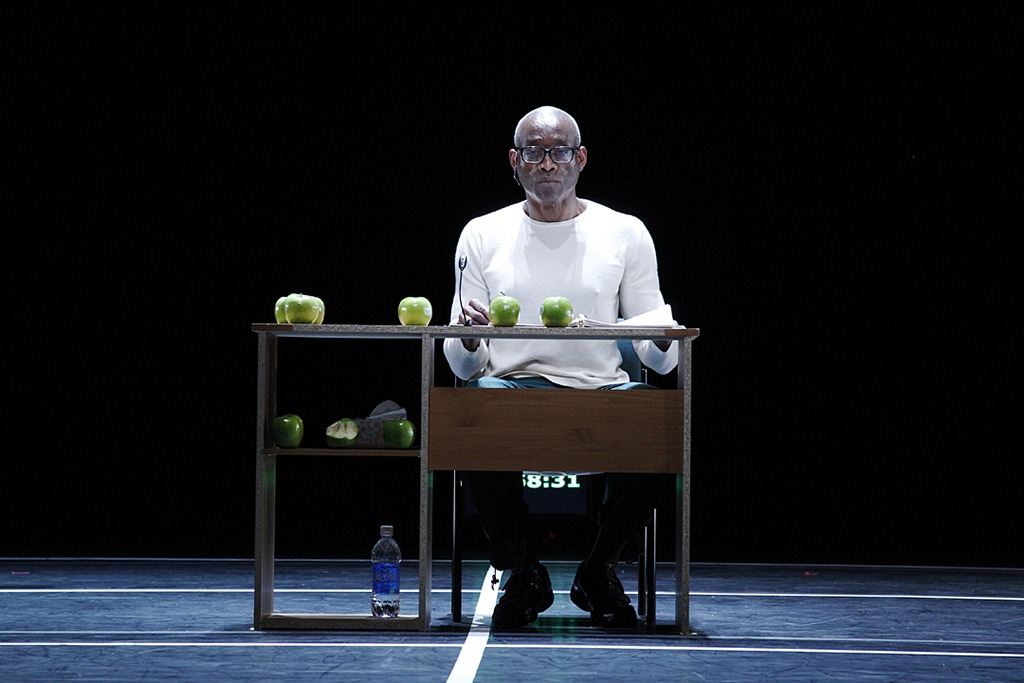THREE DECADES AGO, Bill T. Jones jolted the New York dance scene. Bucking the prevailing stripped-down postmodernism, he and his partner Arnie Zane created sensational dances collaborating with composers, fashion designers, and visual artists. A new queer æsthetic emerged that was anything but minimalist.
When I worked at Walker Art Center in Minneapolis (1988-96), I presented Jones’ dance company on several occasions. During this period, the AIDS epidemic was ravaging his world, killing his lover Arnie Zane (1988) and collaborator Keith Haring (1990), as well as scores of friends, colleagues, and dancers. Consequently, Jones’ work became politicized. Last Supper at Uncle Tom’s Cabin / The Promised Land (1990) had him searching for hope as a gay black man in America. Its final resolving tableau included 52 nude bodies of all shapes, sizes, ethnicities, ages, and genders.

Jones is still creating his iconoclastic dances across a vast array of æsthetic explorations. His collaborators have included everyone from Toni Morrison to the Chamber Society of Lincoln Center to Jessye Norman. His honors include a MacArthur genius award and the National Medal of the Arts from President Obama, but these have not tempered his firebrand energy. Outside his own company, Jones has created dances for Alvin Ailey, the Boston Ballet, and the Berlin Opera Ballet. He directed at the Guthrie Theater in Minneapolis and won two Tony Awards for his choreography in Spring Awakening and Fela!
As a writer, Jones published his memoir Last Night on Earth in 1995 and a children’s book, Dance, in 1998. This fall, Princeton University Press released his Story/Time: The Life of an Idea. Writes Jones in the acknowledgments of his latest book: “Story/ Time is a meditation on John Cage’s Indeterminacy, a 1958 work in which Cage read ninety stories, each one minute long. … Engaging with this seminal work allowed me to examine and interrogate a system of thought and practice grounded in ideas held by many—myself included—striving to understand how Eastern thought, liberation philosophy, and art could be used to redefine reality for both the maker and his or her audience.”
I talked with Jones in October about his new book and projects under development.
John Killacky: Story/Time is such a beautiful homage to John Cage. You’re this hot, politically engaged, out gay artist. I think of Cage as cool, philosophical, quiet, disengaged from the world, a theoretical genius. Can you talk about his influence on you and in particular this project?
Bill T. Jones: He literally represented for me everything cool and removed and sophisticated at a time when I was trying to wend my way into the art world. There was a woman that had known Jasper [Johns] and John Cage. She tried to get them interested in what Arnie [Zane] and I were doing. They were like “No way!” We were too “obvious.” We were too “in your face.” I always felt a little hurt by that. We did meet John later through a mutual friend. I had dinner with John and Merce [Cunningham] and went to a show with him and got to know him as a man. I couldn’t be in that club, but I realized there was a lot to love in him. This book is trying to come to grips with my need to be in the Modernist cool club, and my acceptance that I will not be in that club.
JK: How did this beautiful book come about?
BTJ: The deal with the Morrison Lecture people was we would do three lectures that would result in a book. I had been struggling with this work, trying to mesh these thoughts and ideas of John Cage with my own theatricality and the way my company moves. The process had been so strange and challenging and scary. I thought the lectures would be a great opportunity to talk theoretically about it in the first and third lectures, and show a version of it in one of those wood paneled rooms in an august university. It felt very claustrophobic, very much of a throwback to a world that I’ve only seen in movies. I never went to an Ivy League school. We set this thing up as if it were site-specific and emulated something that he [Cage] would have been able to put forward in 1958: sitting alone at a table in a room, and reading one story after another. The difference was we had a very sophisticated sound design, a rudimentary lighting design, and Bjorn Amelan drawing on the chalkboards before an academic audience. It was wonderful.
JK: Your company is still performing Story/Time?
BTJ: The work is part of our touring repertory. For some of the (recent) New York shows we decided to do the classic version, and then to get rid of some of the “crafting” and strip the place down a couple of times and we had guest artists: Kathleen Chalfont (Angels in America and Wit), Lois Welk (founder of American Dance Asylum) and Theaster Gates (conceptual artist). They wrote some of their own stories, read mine as well, and talked about a personal history.
JK: You juggle multiple projects at any given time. Anything in development now?
BTJ: The new one for the company is a three-part work influenced by W. C. Sebald’s The Emigrants, the story of a Jewish boy who was a “valet” to a rich German boy, an oral history of my husband Bjorn’s 94-year old Jewish mother who survived the war by working in an internment camp in eastern France, and my wild nephew Lance who had drug problems and was a hustler on Polk Street [San Francisco]. In terms of the commercial art world, I would love to be able to talk with you about it. There are a couple projects on the table, but you know how the producers are. We will see which ones go the distance. One is a major motion picture from some years back that was very successful. Now the filmmaker is making it into a musical that I am choreographing.
JK: With all you’ve done and all you’ve achieved, what still drives you to make this ambitious work?
BTJ: For the theater work, there is: “Can I do it? Can I make an entertaining thing that has some integrity?” So that’s maybe my pride. There is also hopefully my retirement; because in the dance world, you will not retire with what the dance world has to offer you . . . The company is the child that Arnie and I had. Every time I make a new work, I get this excitement in my chest. I keep thinking, “Ah, this is the way I understand the world.” This is my religion: something keeps pulling me forward that has to do with art-making as a spiritual activity.
John R. Killacky is executive director of Flynn Center for the Performing Arts in Burlington, Vermont.





